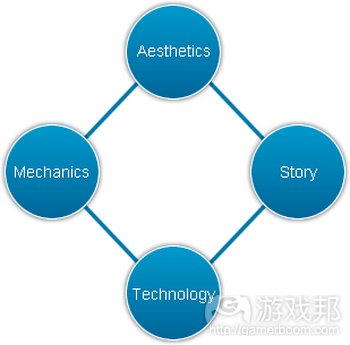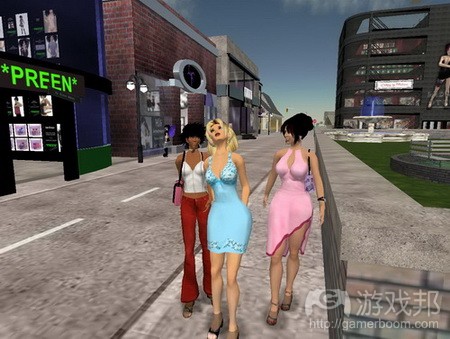以在线学习为例阐述4大游戏化要素
作者:Ben Betts
我常被问及为何“游戏”。我最赞同的游戏定义来自游戏设计元老Jesse Schell:“游戏是个以娱乐态度解决问题的活动”。这有点宽泛,但我认为你很难再给出更出色定义。若你试图更进一步定义游戏,只要有人列举不符游戏,你的定义就不成立。
你或许认为根据定义,在线学习过程也算游戏。但更深入探究你会发现其实并非如此。我通常把在线学习过程描述成“我们获得解决方案,请仔细阅读,而非‘有待解决的问题’”。Cathy Moore凭借其杰出“Action Mapping”解决方案在该领域颇有威望,所以若你遵照他提出的建议,定能有所建树。
在线学习多常以娱乐态度进行?这无关在屏幕顶部附着幽默剪切图。而是涉及带给学习者娱乐氛围。学习者能够进行试验、尝试,即便失败也无任何风险。我们的在线学习过程通常呈直线型,所以娱乐空间非常有限(游戏邦注:我们需以认真态度应对,而非以消遣作为目的)。
所以若我们目前所有在线学习过程都不符合此定义,我们要采取什么措施改变这个局面?我们要如何把在线学习过程游戏化?深入Jesse Schell观点,我们总结出游戏设计4大关键要素。Schell称之为画面效果、故事情节、游戏机制和游戏技术。
画面效果
游戏之所以为游戏是因为它看起来像游戏。这对还是错?
游戏以不同方式呈现。它们以独特而有趣方式充分利用画面效果。例如,《使命召唤》就以其超现实画面著称,这是款畅销作品。但《黑手党战争》是近来一大颇受欢迎的游戏,游戏基于浏览器,几乎是通过文本呈现。你无需创造3D游戏世界,只消利用符合游戏机制风格的画面效果。《黑手党战争》完全关乎信息元素,其最佳呈现方式是借助文本界面。
当然你可以把你的导入程序应用至《第二人生》中。这会让游戏更像电脑游戏,但还无法满足游戏定义标准。若只是出于“看起来像游戏”目的,画面效果通常能够增加可玩性。但这还不足以让某活动成为游戏。深入来看,画面效果不仅涉及视觉外观。我们这里谈及的是所有感官,包括听觉和触觉。
总而言之,画面效果会影响娱乐效果,但你无需创造3D虚拟世界服务游戏开发。
故事情节
我认为游戏化常忽略的一方面是故事情节。游戏让我们能够参与至故事中,能够影响故事发展结局。故事情节关乎游戏制作或分析,促使你考虑这个问题,你想玩这款游戏吗?若不想玩,你就陷入麻烦当中。
我们希望游戏故事能够富有史诗特性。游戏让我们得以进行我们在现实生活中无法进行的活动。我们无需进入完全虚幻的世界(游戏邦注:虽然通常是这样的世界)。由于同现实生活联系密切,游戏变得越来越具吸引力,想想Facebook社交游戏,其中你可以同现实好友竞争。
故事是游戏存在的载体,是有待解决的问题。存在问题需足够复杂,能够构成故事,需能够吸引用户注意力。就拿《Health & Safety》内容来说,之前的《H&S》课程或许有些无聊,内容啰嗦,纯粹是普通常识,堪称信息垃圾场。把这个理念应用至该课程中,以新的游戏化内容开始课程:拯救生命。现在内容就变得有趣。
游戏机制
游戏机制是零碎内容,多数人会认为它们是将内容“游戏化”所需的工具。游戏机制是指促使游戏运作的设置(游戏邦注:包括积分、关卡、钱币和徽章等)。它们也是衡量“输赢”的标准。当然,这些很重要,但不是游戏最重要的内容。
游戏机制存在一定模糊性,它们充当内在或外部激励。当其融入游戏中,只有内在价值,它们通常被视作内在刺激机制的一部分。我所指的“内在价值”是指在游戏中具有重要价值的内容,但在游戏之外毫无价值。《大富翁》钞票是最典型的例子。当玩游戏时,《大富翁》钞票非常重要。但退出游戏后,此无足轻重。
获得游戏徽章是个内在机制,只要内容具有内在价值。若徽章在游戏中毫无意义,完全是奖励游戏以外行为的参考依据,那就是外部刺激,完全没有体现在游戏化学习过程当中。如今玩家通过体验游戏实现外部目标,他们开始对游戏本身失去兴趣。
留心你的游戏机制,防止有人将其当作给予行为外部奖励的基础。游戏机制能帮助玩家评价他们在游戏环境中的表现。但不要使用相同方式评价他们在现实生活中的表现。
游戏技术
所有游戏都有技术基础,只不过其利用方式不同。有些游戏需要的技术只是笔和纸。而其他作品则需运用创新技术。你借助技术的方式将影响玩家“解决”问题能力以及其体验态度。
在X-Box实施解决方案是让用户以娱乐方式思考活动的直接方式(游戏邦注:内容出现在游戏掌机中,所以它属于游戏)。手机应用处在中间地带,虽不如LMS正式,但比游戏掌机更具灵活性。但笔和纸或许就足以让游戏运作。
重要的是游戏技术要能够给予足够参与性,让玩家影响游戏结果。若玩家无法同机制或其他玩家互动,那么游戏技术就会令你失望。社交学习平台扮演重要角色,既是消费系统,也是分配系统。
游戏呈现方式多种多样
通常人们会基于上述某个方面判断什么能够称作游戏。但上述单一方面不足以构成游戏。只有4个方面结合起来方能带来真正游戏体验。
虽然我们缺乏大统一“游戏”理论,但游戏化绝非简单概念。但能够肯定的是上述4方面在游戏化内容中不可或缺。缺乏此理念,你的新游戏化学习过程就很难受欢迎。
利用内在机制、诱人故事情节、合理画面效果和适当技术游戏化学习过程是个美好开端。仅贴个标签,口头宣称,还远不能算是游戏!(本文为游戏邦/gamerboom.com编译,如需转载请联系:游戏邦)
The 4 pillars of Gamification
By Ben Betts
I’m often challenged on what qualifies as a ‘game’. My favourite definition of a game comes from game design guru Jesse Schell who said that “a game is a problem solving activity, approached with a playful attitude”. That’s a pretty broad brush, but I don’t think you can actually get one much finer. If you start to define a game any further, you tend to run into problems when someone brings you an example of a game that doesn’t fit.
You might be inclined to think that your E-learning probably qualifies as a game by this definition. Dig a little deeper though and you realise that it’s probably not the case. Often, I would suggest, E-learning is presented as ‘we’ve got the solution, now read all about it’, rather than a ‘problem to be solved’. Cathy Moore builds on this area with her brilliant Action Mapping technique, so if you follow her sage advice, you might be getting somewhere.
How often is our E-learning approached with a playful attitude? This doesn’t involve sticking a quirky piece of clip art at the top of the screen. What it does involve is evoking a sense of playfulness in your learners; an ability to try things out, to experiment and to fail safely. Often our E-learning is so linear and so push in nature that there is very little scope to ‘play’ with it – it is to be worked through, not played with.
So if we’re a little bit away from meeting the definition in most of our current E-learning offerings, what can we do to change this? How can we gamify our E-learning? Building further on Jesse Schell’s work, there are four key areas to a games design. Schell calls them Aesthetics, Story, Mechanics and Technology.
Aesthetics:
A game is only a game because it looks like a game, right? Wrong!
Games come in many different forms. What they do is to make use of the aesthetics in unique and interesting ways. For instance, Call of Duty is noted for its ultra-realistic graphics and it’s a best-selling franchise. But Mafia Wars is one of the most popular games of recent times and its browser based – mostly text. You don’t have to build a 3D world to make a game, you just have to make use of aesthetics that suit the style of gameplay you want to facilitate. Mafia Wars is all about information and the best way to display that is with a text interface.
Sure, you could take your induction programme and put it into Second Life. That would make it look like a computer game, but it wouldn’t be enough to meet our definition of a game. More often than not, Aesthetics help to encourage playfulness, if for no other reason than to make something ‘look like a game’. But they aren’t enough to make something a game in and of itself. Taking this further, it is important to realise that aesthetics aren’t just about visual appearance. We’re talking about engaging all of the sense here; think sound, think touch.
In short, aesthetics will influence a sense of playfulness, but you don’t have to make a 3D virtual world to make a game.
Story
For me, one of the most oft overlooked areas of gamification is the story. Games allow us to take part in stories and influence the outcome. The story is the making or the breaking of the game and allows you to answer the question, would you want to play this game? If not, you’ve got a problem.
Typically we would expect a games story to have something of the Epic in its nature. Games give us the opportunity to do something which we couldn’t normally do in real-life. This doesn’t need to go into the world of complete fantasy (although it often does). Increasingly games are becoming more appealing because of their links into real-life – think of Facebook’s social games where you compete against your real-life friends.
The story is your games reason for being, your problem to be solved. Your problem needs to be big enough to warrant a story and it needs to appeal to people’s curiosity. Take Health & Safety for example. Previously your H&S course might have been somewhat dull; a preachy, common sense, information dump. Throw that idea in the trash and start with a new, gamified premise: the quest to save a life. Now that’s interesting.
Mechanics
Mechanics are the bits and pieces that most people would consider the tools they need to “gamify” an experience. Game Mechanics refer to the mechanisms by which the game itself works, be that points, levels, cash, badges or whatever. They are also the measure by which we ‘win’. Of course, these are important, but they are not the be all and end all of a game.
There abounds a level of confusion about mechanics and their presence as an intrinsic or extrinsic motivator. When they are tied implicitly into a game and hold only an endogenic value, they can be seen as a part of the intrinsic motivation mechanism. When I say ‘endogenic value’, what I’m referring to is something which holds great value inside the game, but none outside it. Monopoly money is the classic example. When you are playing the game, gameogre.com money is vital. When you aren’t playing Monopoly you couldn’t care less about it.
Achieving badges within a game is an intrinsic mechanic, so long as there remains an endogenic value for them. If the badges are of no significance within the game and are solely used as a basis to reward behaviour outside of the game, then they have become an extrinsic motivator and have no real place in your gamified learning. Now people are playing the game to reach some external goal, they are going to start losing interest in the game itself.
Be careful with your mechanics and don’t let anyone use them as a basis to extrinsically reward behaviour. Mechanics help a player to evaluate their competence within the game environment. Don’t be tricked into using the same measures to evaluate their competence in real-life.
Technology
All games have a foundation in technology, they just use it differently. Some games require no more technology than a pencil and paper. Others require innovative and new technology to be implemented. How you use technology will play into both the ability of your players to “solve” problems and also the attitude with which they approach the experience.
Deploying your solution on an X-Box is an obvious path to getting people thinking about the experience in a playful attitude – it is on a games console, therefore it is a game. Apps for smartphones are a nice middle ground for this; less formal than the LMS, but more flexible than a games console. But it might be that a pencil and paper is enough technology for your game to work.
What is important is that your technology allows for sufficient participation for players to influence the outcome. If players can’t interact with either the system or other players, then your technology is going to fail you. Social Learning platforms have a big role to play here as both systems of consumption and contribution.
Games come in many forms
Often, people are quick to judge what qualifies as a game based on just one of these pillars. But the pillars in isolation are really never enough to qualify as a game. It is the combination that brings the true game experience.
Whilst we lack a grand unified theory of ‘games’, gamification will be a difficult concept to get your head around. However, it is safe to assume that gamification requires an appreciation of all 4 pillars. Without this appreciation, it seems likely that your new gamified learning experience won’t be as well received as it might be.
Use endogenic mechanics, a compelling storyline, suitable aesthetics and the most appropriate technology to gamify your learning and you’ll be off to a good start. Slapping a badge on it and calling it a game simply will not suffice!(Source:ht2)










































 闽公网安备35020302001549号
闽公网安备35020302001549号